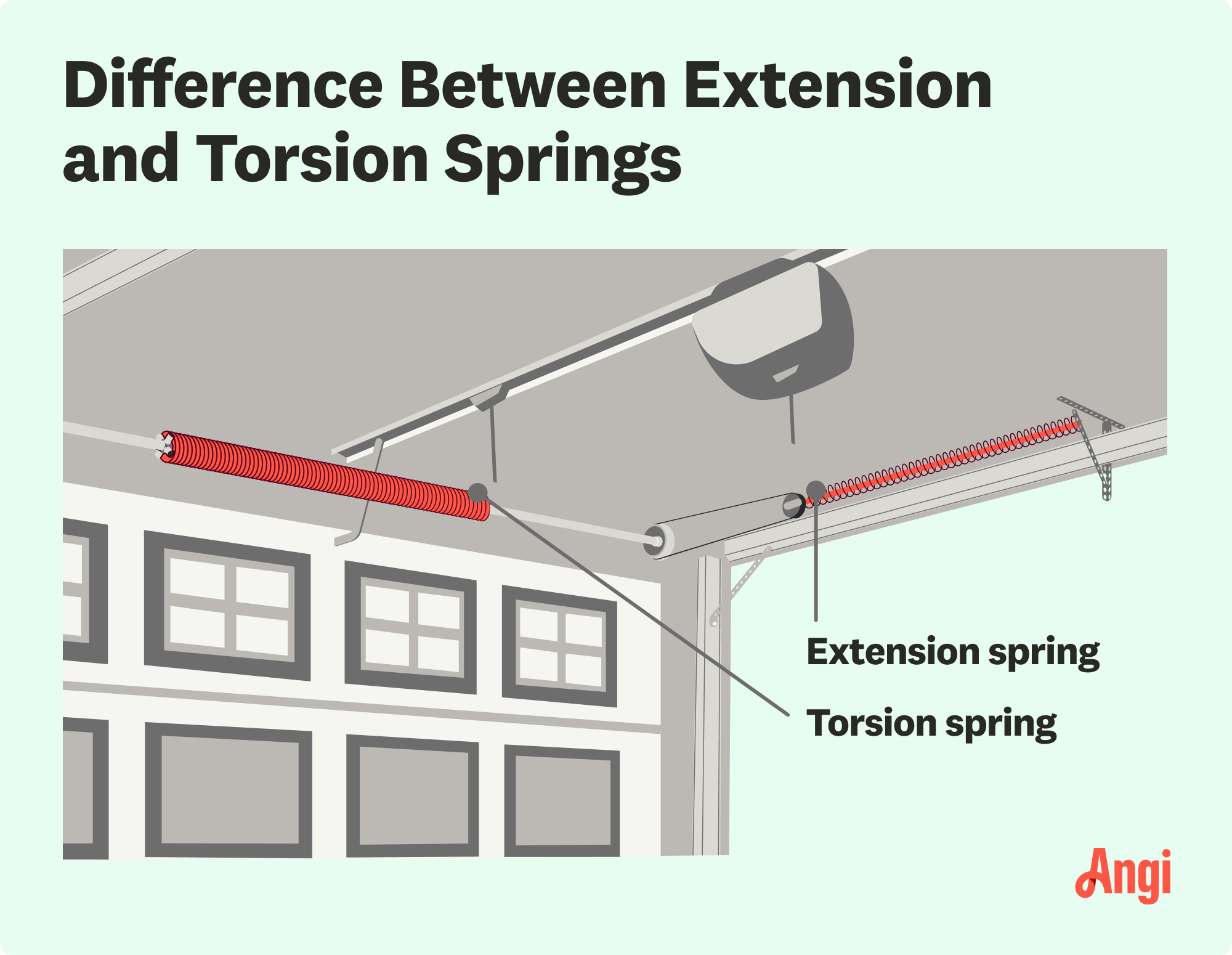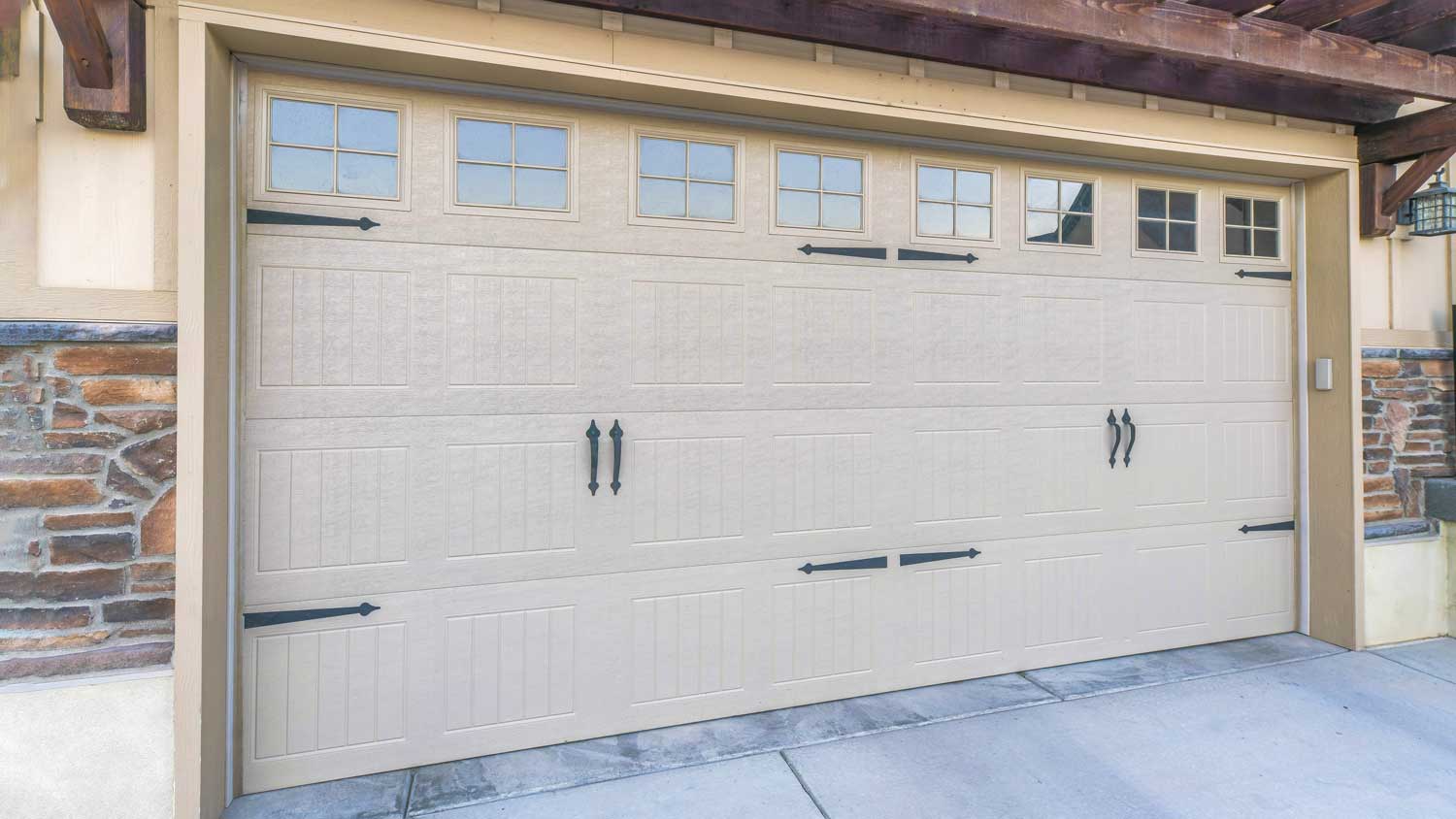How Much Does Garage Door Spring Replacement Cost? [2025 Data]
Garage door spring replacement costs $250 on average, or between $150 and $350, depending on the spring type.


If your garage door isn't opening or closing properly, you may need to replace the door’s springs. Garage door spring replacement costs $250 on average, with prices often ranging from $150 to $350 or more. A reliable garage door protects your home from security threats and the elements while also making daily life more convenient. However, it must work properly to be helpful. Read on to learn about all the factors that impact the cost of replacing your garage door springs.
What Factors Influence the Cost to Replace Garage Door Springs?
A few factors impact the cost to replace a garage door spring, including:
Spring Type

| Type of Spring | Average Cost |
|---|---|
| Extension spring | $50–$100 |
| Torsion spring | $75–$150 |
| Convert torsion to extension | $250–$500 |
| Convert extension to torsion | $400–$800 |
Garage doors operate with either extension or torsion springs. While extension springs might be cheaper, torsion springs have longer lifespans and are generally considered safer. It’s possible to switch from one type of spring to another, but switching means a professional has to remove the old spring parts to install an entirely new system. And that, of course, increases your total garage door spring replacement cost—it’s roughly five times as expensive to do a garage door spring conversion.
Type of Garage Door
| Type of Garage Door | Replacement Cost (per Spring) |
|---|---|
| Sectional | $75–$150 |
| Tilt-up | $50–$100 |
| Roll-up | $75–$150 |
Garage door springs are integral to how most garage doors work. Garage door spring replacement costs can depend on the type of garage door: sectional, tilt-up, or roll-up.
Sectional garage doors are the most common type of garage door in the United States. The horizontal panels that make up the garage door are connected via hinges, and one by one, the panels roll up and inside a vertical track.
Tilt-up garage doors, also called one-piece garage doors, do exactly as their name implies: You tilt up the door and move it back along its tracks. Roll-up garage doors are common in commercial settings; the narrow steel panels coil up just above the opening.
Tilt-up garage doors use extension springs. Roll-up garage doors use torsion springs, which are more expensive to replace. Both extension and torsion springs are common on sectional doors.
Replacing garage doors and garage door springs can be dangerous. Garage doors are very heavy and the springs are under a lot of tension. A garage door pro has the tools and experience to do this project safely.
Number of Doors
| Number of Garage Doors | Average Spring Replacement Cost |
|---|---|
| One | $150–$350 |
| Two | $275–$425 |
| Three | $350–$700 |
You’ll pay between $150 and $350 for a single garage door. Costs could potentially run as high as $500 if you have to replace springs for several doors or have to make related repairs. When one door garage spring fails, it’s better to replace both springs at the same time to maintain the door's balance. Plus, a contractor will likely give you a good deal if you replace both during the same visit.
For example, your garage door repair tech must make a trip to your home, whether replacing springs for a single door or three doors. Replacing springs on multiple garage doors can minimize labor costs by reducing trip time. However, the material price will increase by the cost of additional springs per door.
Double-door springs can cost an extra $15 to $30 per spring compared to a single-door.
Accessibility
If a pro has a hard time accessing the garage, it could increase your labor costs. Difficulty accessing the garage or the spring itself means more time tacked onto the labor portion of the contractor’s bill.
Labor
For residential garage doors, spring replacement runs between $75 to $150, while commercial-grade springs can cost between $150 and $300 to replace. Due to the dangers of DIY work on garage door springs, contacting a pro who fixes garage doors is crucial for this job.
Location
In some cases, your location might affect the cost to replace a garage door spring. Labor rates tend to be higher in areas with a high cost of living, like large cities, compared to areas with a lower cost of living, such as rural and suburban towns. But if you live in a rural area and your pro needs to make a long trip to get to your house, they might charge more than if you lived closer.
Urgency
Emergencies happen. If time is of the essence, you should call an emergency garage door repair contractor near you, though their services tend to cost more. If a spring is broken, the garage door is stuck for an unknown reason, or you're unsure of the problem with your garage door, you should avoid potential injury by not opening the door manually.
Additional Factors to Consider
A few additional factors can impact how much you will spend to replace your garage door springs.
Additional Garage Repairs
Your garage door relies on several important components to operate safely and smoothly. Since you’re already paying a contractor their base fee to show up and make the repairs, it’s worth asking them to take a closer look at your entire garage door system and ensure everything else is running as it should.
They might notice issues beyond the spring(s) that need to be replaced. Other garage door components that might need repairs over time include:
Cables
Rollers
Tracks
Hinges
Weatherstripping
Sensors
Bottom seal
Garage door opener
Garage Door Spring Maintenance
Your garage door springs require regular maintenance over time to ensure they operate without issue for their entire lifetime. Two to three times a year, you should lubricate the garage door springs (and other key garage components).
While you can hire a garage door contractor for this service, it’s also viable as a DIY project: here’s how to lubricate your garage door on your own. Your only cost will be the lithium- or silicone-based lubricant. Just remember to clean the springs before you lube them.
You should also inspect your garage door springs for imbalance and check their tension every few months.
Quality of the Spring
The cost of the garage door springs themselves can vary depending on their quality. Some brands manufacture budget springs, while others charge more for springs that are of a higher quality. A middle-of-the-road spring gets you the best of both worlds: decent quality at a fair price.
Spring Strength
Heavier garage doors require larger (and stronger) springs. The typical seven-foot-tall garage door needs 25-inch springs; eight-foot-tall garage doors require 27-inch springs. The price difference here is minimal (maybe $5 to $10 per spring or set of springs, depending on where you buy them), but larger springs cost more.
Cost to Replace a Garage Door Spring Yourself
You should never attempt a DIY garage door spring replacement. While you could save on the cost of labor by replacing garage door springs yourself, the savings are trivial compared to the danger involved in attempting the task on your own.
Garage door springs are under a lot of tension, so improper handling or a sudden release can lead to serious injury or worse.
Garage doors are also quite heavy, and repairs often require specialized tools, so calling a local garage door spring repair pro to replace your springs is essential for your safety.
Signs Garage Door Springs Need to Be Replaced
If your garage door exhibits any of the following behaviors, it’s likely time for a garage door tuneup or spring replacement.
Garage Door Issues
Common signs that you need new garage door springs include:
The door isn't hanging straight.
The door lowers faster than usual.
The door won't stay open on its own.
You notice visible gaps in the springs.
The garage door makes a lot of noise.
You notice loose or broken cables.
Springs Are Starting to Rust
Garage door springs can rust when exposed to moisture, so it's a particular concern for homeowners in coastal regions. More than unsightly, rust can degrade the spring over time, rendering it useless. To prevent rust, lightly lubricate the springs each year using a lithium-based lubricant. Homeowners in coastal regions might need to lubricate them several times per year due to moisture in the air.
Screeching Noises
If you hear screeching noises, it's possible that the springs are too tight or too loose. However, it's more likely due to worn-out or frayed cables. Bent or damaged tracks can also cause the garage door to screech.
Spring Replacement vs. Garage Door Replacement
When your garage door suddenly won’t open or close, you might feel that impending sense of dread because you have to buy a new garage door.
And who could blame you? It’s a lot of money. Replacing a garage door costs $750 to $1,700, while a garage door spring replacement costs an average of just $250.
Luckily, you may only need to replace the garage door springs. Call a garage door technician to check out the issue. If the only problem is the garage door springs, you’re in the clear. But if the pro reports issues with multiple components, such as the cables, pulleys, tracks, or the garage door itself, it’s probably time to fully replace the garage door.
In the long run, it’s likely more affordable than taking a piecemeal approach and repairing each part of the broken garage door as it fails.
Tips to Reduce the Cost of Replacing Garage Door Springs
There are several ways to potentially reduce the cost of replacing a garage door spring, including:
Getting estimates from multiple pros to find the best price.
Asking companies about any seasonal promotions or discounts.
Regularly maintaining and lubricating your garage door to prevent the need for repairs.
Buying the springs yourself.
How Angi Gets Its Cost Data
Home is the most important place on earth, which is why Angi has helped more than 150 million homeowners transform their houses into homes they adore. To help homeowners with their next project, Angi provides readers with the most accurate cost data and upholds strict editorial standards. We extensively research project costs to develop the pricing data you see, so you can make the best decisions for you and your home. We rely on reputable sources, including the U.S. Bureau of Labor Statistics, academic journals, market studies, and interviews with industry experts—all to ensure our prices reflect real-world projects.
Want to help us improve our cost data? Send us a recent project quote to costquotes@angi.com. Quotes and personal information will not be shared publicly.
Frequently Asked Questions
You should change both springs on a garage door, even if just one breaks. Most garage doors come with two springs. Once one of them breaks, replacing both at the same time will ensure that the door stays balanced and strong. It may even prevent you from having to make extra costly repairs because of a potential imbalance.
Garage door springs can be used for 10,000 to 20,000 cycles. Over time, when your garage door fails, the springs are the part that most often breaks. So you'll need to replace a torsion spring every 8 to 15 years and an extension spring every about 7 to 12 years, depending on use.
You should never open a garage door with a broken spring. Once a spring breaks, the door becomes too heavy to lift safely. So refrain from attempting to do so yourself. It's best to wait for a garage door repair person to open it for you. They can safely open the door, repair the springs quickly, and quickly get your garage back to working order.















